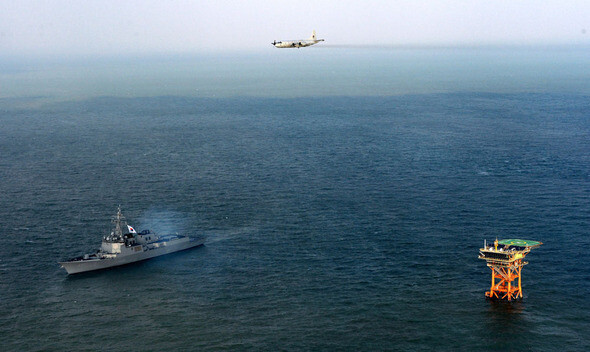hankyoreh
Links to other country sites 다른 나라 사이트 링크
S. Korean civilian aircraft won’t provide flight plans to China

By Kim Kyu-won and Noh Hyun-woong, staff reporters
The government decided to continue instructing South Korean civilian aircraft that are passing through China’s air defense identification zone (ADIZ) not to submit their flight plans to China. The US already advised its civilian aircraft flying through the zone to inform China of their flight plans. The Japanese government, which is preventing its civilian aircraft from submitting flight plans as South Korea is, reportedly expressed its dismay about the American measures.
“The flight path from Korea to Southeast Asia passes through the air defense identification zone announced by China, but we have told civilian airlines not to provide their flight plans to China just as they have done in the past,” an official at the Ministry of Land Infrastructure and Transport who spoke on condition of anonymity said on Dec. 2.
“This route is approved by the International Civil Aviation Organization, and air defense identification zones have no standing in international law. It is our position that China cannot take any coercive action against civilian aircraft,” the official said. However, civilian aircraft flying from South Korea to China naturally submit their flight plans to the country since they are passing through its air space, and these are also shared with the Chinese air force.
The South Korean government decided to postpone the announcement of the expansion of it ADIZ to include Ieo Island until after this week’s visit by US Vice President Joseph Biden (Dec. 5-7).
According to the ministry’s guidelines, aircrafts hailing from South Korea will not submit flight plans when they only pass through China’s air defense identification zone without entering its airspace.
“Since this is not an issue for airlines to decide on their own, we don’t have any particular opinion on that matter,” said Ma Jae-young, head of public relations for Asiana Airlines. “The US and Japanese governments have their own positions on the issue. All we will do is follow the directions of the Ministry of Land, Infrastructure and Transport.”
When asked about the safety of passengers and any concerns they might have, Ma said, “The air defense identification zone that China announced does not affect civilian aircraft. We are operating our aircraft according to standard practice.”
The South Korean government is maintaining a wait-and-see attitude regarding the controversy about whether American and Japanese civilian aircraft that are entering China’s ADIZ will provide their flight plans to the country.
“If we provide flight plans to China too easily, it will give China a say over that airspace,” the ministry official said. “Since this would be acknowledging the air defense identification zone declared by China, we will have to consider this carefully.”
Fortunately, the Chinese government is not strongly demanding that South Korean civilian aircraft flying through its ADIZ provide their flight plans. The Ministry of Land Infrastructure and Transport is carefully reviewing China’s attitude and the responses of other countries in the region.
“The operation of civilian aircraft is not regulated by air defense identification zones but rather by the flight information regions that are determined by the International Civil Aviation Organization,” said Ministry of National Defense spokesperson Kim Min-seok. “Chinese military aircraft can take no action whatsoever against a civilian aircraft that is operating normally. Since the South Korean government is unable to recognize China’s air defense identification zone, we are not instructing airlines to submit their flight plans.”
Please direct questions or comments to [english@hani.co.kr]

Editorial・opinion
![[Guest essay] Maybe Korea’s rapid population decline is an opportunity, not a crisis [Guest essay] Maybe Korea’s rapid population decline is an opportunity, not a crisis](https://flexible.img.hani.co.kr/flexible/normal/500/300/imgdb/original/2024/0430/9417144634983596.jpg) [Guest essay] Maybe Korea’s rapid population decline is an opportunity, not a crisis
[Guest essay] Maybe Korea’s rapid population decline is an opportunity, not a crisis![[Column] Can Yoon steer diplomacy with Russia, China back on track? [Column] Can Yoon steer diplomacy with Russia, China back on track?](https://flexible.img.hani.co.kr/flexible/normal/500/300/imgdb/original/2024/0430/1617144616798244.jpg) [Column] Can Yoon steer diplomacy with Russia, China back on track?
[Column] Can Yoon steer diplomacy with Russia, China back on track?- [Column] Season 2 of special prosecutor probe may be coming to Korea soon
- [Column] Park Geun-hye déjà vu in Yoon Suk-yeol
- [Editorial] New weight of N. Korea’s nuclear threats makes dialogue all the more urgent
- [Guest essay] The real reason Korea’s new right wants to dub Rhee a founding father
- [Column] ‘Choson’: Is it time we start referring to N. Korea in its own terms?
- [Editorial] Japan’s rewriting of history with Korea has gone too far
- [Column] The president’s questionable capacity for dialogue
- [Column] Are chaebol firms just pizza pies for families to divvy up as they please?
Most viewed articles
- 1Under conservative chief, Korea’s TRC brands teenage wartime massacre victims as traitors
- 2Months and months of overdue wages are pushing migrant workers in Korea into debt
- 3[Guest essay] Maybe Korea’s rapid population decline is an opportunity, not a crisis
- 4[Column] Can Yoon steer diplomacy with Russia, China back on track?
- 5First meeting between Yoon, Lee in 2 years ends without compromise or agreement
- 6After election rout, Yoon’s left with 3 choices for dealing with the opposition
- 7[Column] Behind factional animus of Korean politics, victim mentality festers
- 8‘We must say no’: Seoul defense chief on Korean, USFK involvement in hypothetical Taiwan crisis
- 9[Editorial] Japan’s removal of forced labor memorial tramples on remembrance, reflection and friends
- 10[Guest essay] A society in which old age becomes a burden